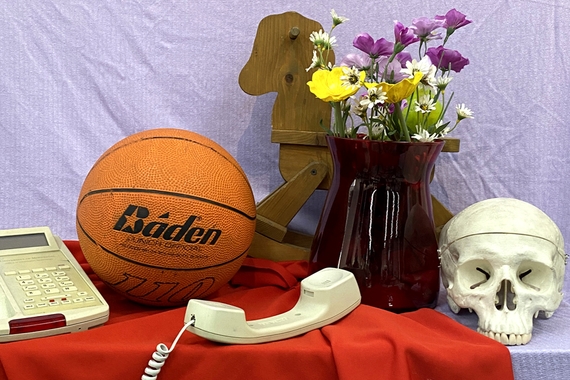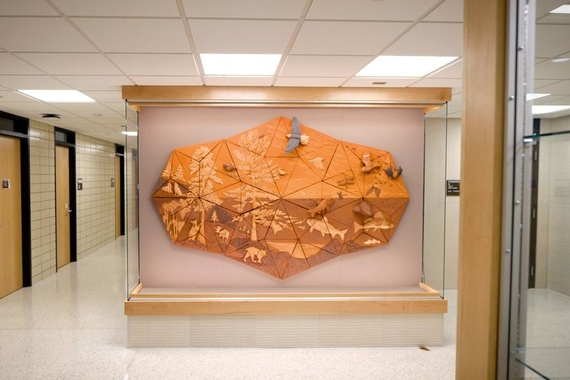A Creative Life in Print
My goal is help students develop their own critical voice and have the technical skills to drive their own projects....Ultimately, my goal is to eliminate myself.
Is it when an arts educator has eliminated their main purpose for their students that they've succeeded? From being in the right place at the right time, to finding a somewhat circuitous path to teaching, Professor and Director of Graduate Studies Jenny Schmid is a working artist that seeks to help students navigate academia and harness their creative voice.
As we ready for a fall full of unique challenges for arts educators and students, we asked Jenny take a break from planning and artmaking to meander down memory lane and back.
Q: When did you decide to pursue art as a career?
A: It kind of decided me. I remember loving fingerpainting as a kindergartener and continually making art as I grew-up, always motivated to do a drawing every single day. At Macalester College, I studied political science and economics, and that's when I realized that art is a place where all your ideas can meet. That it [art] could be the thing that incorporated social issues, politics, literature, music, archives of historical print images - everything that inspired me.
In terms of printmaking, while I mostly grew-up In the Pacific Northwest, my family moved for a year to the Washington DC suburbs when I was in high school. Slightly out-of-place, the art teacher noticed me and connected me to the school's program with the Smithsonian Institute to learn etching from a master printer. There I was in a basement studio in Washington, d.c., listening to Dancehall Reggae and learning intaglio techniques from a master printer at the age of 16. I was in the right place at the right time.
Q: What inspired you to become an arts educator?
A: After earning an MFA at Stamps School of Art & Design at the University of Michigan, I was awarded a Fulbright scholarship, which allowed me to travel and work in Slovakia. When I came back to Michigan, I was living in Detroit and continued to work as an artist, and began to teach part-time at a community college and a state university. To see students from across backgrounds and experiences come together and acquire technical skills and critical thinking was powerful. I think that's what I like so much about printmakers too, the shared studios and willingness to share knowledge in community.
Working at the University of Minnesota--a research university--elevates my abilities as an educator and as a working artist. Here, creative life and research life are interwoven. That allows me to continue to build my ideas and technical skills, involve students in unique projects, and share newly acquired knowledge and art world connections more broadly in the classroom.
Q. How do you approach teaching?
A: My goal is help students develop their own critical voice and have the technical skills to drive their own projects. It's learning how to learn, how to research your own projects. Ultimately, my goal is to eliminate myself. I see this a lot in my advanced classes, by the mid-end of the semester, students are fully in their own creative vision, they have confidence and technical skills to reach their objectives, find inspiration and communicate their ideas. My role becomes much more of a mentor. But, that's what I like about the U, many graduates stay here to take advantage of the strong arts community and we have a long-term connection. A mentor for life.
Q. What do you do in your role as Director of Graduate Studies?
A: This has been a great opportunity to work with Senior Academic Advisor Patricia Straub on the Graduate Studies "nuts and bolts" to ensure an effective and well funded competitive program. In my role, I support the graduate students' to explore new media, make new connections, develop their professional skills, and travel. It's an exciting program and amazing to meet and learn from graduate students who come from all different backgrounds, artistry, and skills and see how they develop their work through their engagement with the faculty and each other. Now in my third year in this role, I feel like we are ready to explore new long-term concepts of what we want the program to be and where it could go from here.
Q: What's your favorite thing to highlight about the Dept. of Art MFA program?
A: MFA students are connected to an area or medium as a "homebase," but we offer an interdisciplinary arts approach, meaning students have the opportunity to delve into other areas, ideas, and experiences at a major research University. Students take outside classes that inspire their ideas, from puppetry and performance to global feminist perspectives.
Q: In your own artmaking life, you've got a brand or perhaps moniker, "bikini press international," what's the driver behind that concept?
A: It started while printing in Detroit in a studio without air conditioning. It was a hot and humid midwestern summer and the lack of AC inspired problem-solving--printmaking in a "bikini with an apron! Printmaking is both singular, but so much a community as well, "bikini press international" reflects this versatility.
Q: Do you have a favorite song/playlist or podcast you groove to when you make art?
A: Without music, I'm not sure I'd be an artist. My latest listens include: Little Dragon, Koçani Orkestar, IE, and Radio K.



